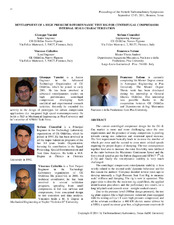| dc.contributor.other | Turbomachinery Symposium (40th : 2011) | |
| dc.creator | Vannini, Giuseppe | |
| dc.creator | Cioncolini, Stefano | |
| dc.creator | Calicchio, Vincenzo | |
| dc.creator | Tedone, Francesco | |
| dc.date.accessioned | 2017-10-04T19:55:15Z | |
| dc.date.available | 2017-10-04T19:55:15Z | |
| dc.date.issued | 2011 | |
| dc.identifier.uri | https://hdl.handle.net/1969.1/163007 | |
| dc.description | Lecture | en |
| dc.description | pg. 46-59 | en |
| dc.description.abstract | The current centrifugal compressor design for the Oil & Gas market is more and more challenging since the cost requirements and the presence of many competitors is pushing towards casing size reduction and rotational speed increase. The first requirement basically leads to increase the number of wheels per rotor and the second to cross more critical speeds requiring the proper degree of damping. The two consequences together lead also to increase the rotor flexibility ratio (defined as the ratio between the Maximum Continuous Speed and the first critical speed as per the Fulton diagram and API617 7th ed. [1-2]) and finally the rotordynamic stability is very much challenged. The centrifugal compressors rotordynamic stability is then strictly related to the internal seals’ dynamic behaviour and for this reason the authors’ Company decided several years ago to develop internally a High Pressure Seal Test Rig to measure seals’ stiffness and damping. The rig is now in operation. This paper aims to describe the main test rig capabilities, the applied identification procedures and the preliminary test results on a long labyrinth seal (smooth rotor - straight toothed stator). Due to the pressure level (500bar design pressure), the test rig plant appears like a high-pressure industrial plant equipped with the testing cell (a 1:1 scale high pressure compressor) and all the relevant auxiliaries: a 400 kW electric motor (driven by a VFD), a speed increaser gear box, a high pressure reservoir (6 m 3 ) with a volumetric compressor to fill it, high pressure pipes and valves. The testing cell is composed of a high-pressure compressor casing with stator parts capable to regulate the seal inlet swirl and a rotor running on Active Magnetic Bearings (AMBs), which serve as exciters (5kN MAX Force over a 0-330 Hz frequency range per axis) and displacement transducers. Special instrumentation is installed into the testing cell in order to measure the main test parameters: seal upstream/downstream gas pressure, upstream temperature and swirl and mass flow. Industrial high-pressure instrumentation is installed on the plant for regulation and monitoring purpose. Maximum test pressure is 350bar and maximum rotational speed is 15000rpm. Test gas is nitrogen. The AMBs control-system capabilities have been tuned to define several alternative excitation patterns and the relevant state of the art identification techniques have been applied. The first seal tested is a long labyrinth seal to simulate a centrifugal compressor balance piston seal. Test results and comparison with a commercial bulk flow code predictions will be fully described. Finally, the future test program will be showed. | en |
| dc.format.medium | Electronic | en |
| dc.format.mimetype | application/pdf | |
| dc.language.iso | en | |
| dc.publisher | Texas A&M University. Turbomachinery Laboratories | |
| dc.relation.ispartof | Proceedings of the 40th Turbomachinery Symposium | en |
| dc.subject.lcsh | Turbomachines | en |
| dc.title | Development Of A High Pressure Rotordynamic Test Rig For Centrifugal Compressors Internal Seals Characterization | en |
| dc.type.genre | Presentation | en |
| dc.type.material | Text | en |
| dc.identifier.doi | https://doi.org/10.21423/R16H09 | |


